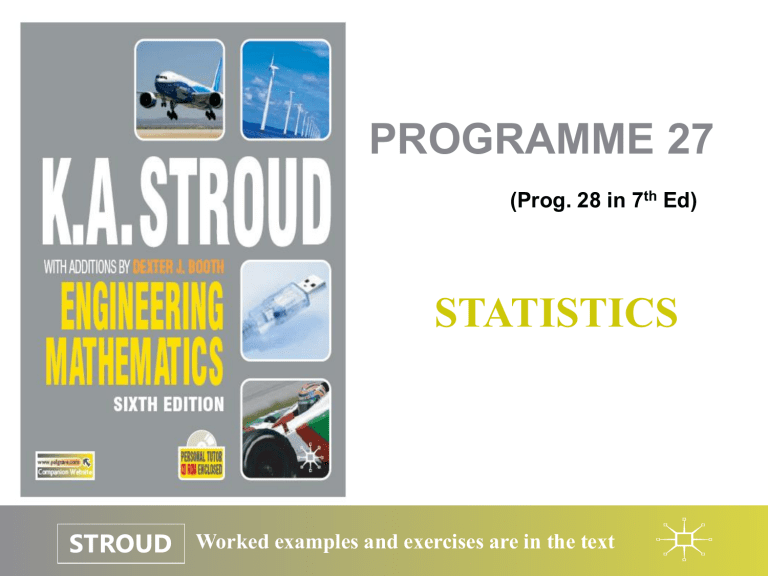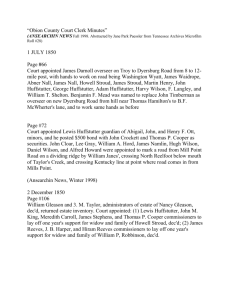Statistics

PROGRAMME 27
(Prog. 28 in 7 th Ed)
STATISTICS
STROUD
Worked examples and exercises are in the text
Tetxtbook 6 th Ed, Programme 27: Statistics
(Prog. 28 in 7 th Ed)
Introduction
Arrangement of data
Histograms
Measure of central tendency
Dispersion
(remaining topics listed in book will not be covered)
STROUD
Worked examples and exercises are in the text
Introduction
Arrangement of data
Histograms
Measure of central tendency
Dispersion
Programme 27: Statistics
STROUD
Worked examples and exercises are in the text
Programme 27: Statistics
Introduction
Statistics is concerned with the collection, ordering and analysis of data.
Data consists of sets of recorded observations or values. Any quantity that can have a number of values is a variable . A variable may be one of two kinds:
(a) Discrete – a variable whose possible values can be counted
(b) Continuous
– a variable whose values can be measured on a continuous scale
STROUD
Worked examples and exercises are in the text
Introduction
Arrangement of data
Histograms
Measure of central tendency
Dispersion
Programme 27: Statistics
STROUD
Worked examples and exercises are in the text
Programme 27: Statistics
Arrangement of data
Table of values
Tally diagram
Grouped data
Grouping with continuous data
Relative frequency
Rounding off data
Class boundaries
STROUD
Worked examples and exercises are in the text
Programme 27: Statistics
Arrangement of data
Table of values
A set of data:
28 31 29 27 30 29 29 26 30 28
28 29 27 26 32 28 32 31 25 30
27 30 29 30 28 29 31 27 28 28
Can be arranged in ascending order:
25 26 26 27 27 27 27 28 28 28
28 28 28 28 29 29 29 29 29 29
30 30 30 30 30 31 31 31 32 32
STROUD
Worked examples and exercises are in the text
Programme 27: Statistics
Arrangement of data
Table of values
Once the data is in ascending order:
25 26 26 27 27 27 27 28 28 28
28 28 28 28 29 29 29 29 29 29
30 30 30 30 30 31 31 31 32 32
It can be entered into a table.
The number of occasions on which any particular value occurs is called the frequency , denoted by f .
Value
28
29
30
31
32
25
26
27
Number of times
5
3
7
6
2
1
2
4
STROUD
Worked examples and exercises are in the text
Programme 27: Statistics
Arrangement of data
Tally diagram
When dealing with large numbers of readings, instead of writing all the values in ascending order, it is more convenient to compile a tally diagram , recording the range of values of the variable and adding a stroke for each occurrence of that reading:
STROUD
Worked examples and exercises are in the text
Programme 27: Statistics
Arrangement of data
Grouped data
If the range of values of the variable is large, it is often helpful to consider these values arranged in regular groups or classes .
STROUD
Worked examples and exercises are in the text
Programme 27: Statistics
Arrangement of data
Grouping with continuous data
With continuous data the groups boundaries are given to the same number of significant figures or decimal places as the data:
STROUD
Worked examples and exercises are in the text
Programme 27: Statistics
Arrangement of data
Relative frequency
If the frequency of any one group is divided by the sum of the frequencies the ratio is called the relative frequency of that group. Relative frequencies can be expressed as percentages:
STROUD
Worked examples and exercises are in the text
Programme 27: Statistics
Arrangement of data
Rounding off data
If the value 21.7 is expressed to two significant figures, the result is rounded up to 22. similarly, 21.4 is rounded down to 21.
To maintain consistency of group boundaries, middle values will always be rounded up. So that 21.5 is rounded up to 22 and 42.5 is rounded up to 43.
Therefore, when a result is quoted to two significant figures as 37 on a continuous scale this includes all possible values between:
36.50000… and 37.49999…
STROUD
Worked examples and exercises are in the text
Programme 27: Statistics
Arrangement of data
Class boundaries
A class or group boundary lies midway between the data values. For example, for data in the class or group labelled:
7.1 – 7.3
(a) The class values 7. 1 and 7.3 are the lower and upper limits of the class and their difference gives the class width.
(b) The class boundaries are 0.05 below the lower class limit and 0.05 above the upper class limit
(c) The class interval is the difference between the upper and lower class boundaries.
STROUD
Worked examples and exercises are in the text
Programme 27: Statistics
Arrangement of data
Class boundaries
(d) The central value (or mid-value) of the class interval is one half of the difference between the upper and lower class boundaries.
STROUD
Worked examples and exercises are in the text
Introduction
Arrangement of data
Histograms
Measure of central tendency
Dispersion
Programme 27: Statistics
STROUD
Worked examples and exercises are in the text
Histograms
Frequency histogram
Relative frequency histogram
Programme 27: Statistics
STROUD
Worked examples and exercises are in the text
Programme 27: Statistics
Histograms
Frequency histogram
A histogram is a graphical representation of a frequency distribution in which vertical rectangular blocks are drawn so that:
(a) the centre of the base indicates the central value of the class and
(b) the height of the rectangle represents the class frequency [i.e., the number of values found to fall in the class – J.A.B.]
STROUD
Worked examples and exercises are in the text
Programme 27: Statistics
Histograms
Frequency histogram
For example, the measurement of the lengths of 50 brass rods gave the following frequency distribution:
STROUD
Worked examples and exercises are in the text
Histograms
Frequency histogram
This gives rise to the histogram:
Programme 27: Statistics
STROUD
Worked examples and exercises are in the text
Programme 27: Statistics
Histograms
Relative frequency histogram
A relative frequency histogram is identical in shape to the frequency histogram but differs in that the vertical axis measures relative frequency .
STROUD
Worked examples and exercises are in the text
Introduction
Arrangement of data
Histograms
Measure of central tendency
Dispersion
Programme 27: Statistics
STROUD
Worked examples and exercises are in the text
Measure of central tendency
Mean
Mode of a set of data
Mode of a grouped frequency distribution
Median of a set of data
Median with grouped data
Programme 27: Statistics
STROUD
Worked examples and exercises are in the text
Programme 27: Statistics
Mean
The arithmetic mean of a set of n observations is their average: x mean = sum of observations number of observations
that is x
x n
When calculating from a frequency distribution, this becomes: x
xf
n
xf f
[Here x now means not the individual observations, but the different values for which frequencies are counted – J.A.B.]
STROUD
Worked examples and exercises are in the text
(Simple) Coding Method for Calculating a Mean Manually or Mentally
[Slide added by J.A.B.]
The textbook mentions a “coding” method for calculating the mean. In class I go through a simplified, very useful version of this. It’s easy: instead of averaging the values themselves directly, you take a convenient number, the
“base”, that’s very roughly in the middle of or near to the values. You work out their (positive or negative) deviations from that base value, take the average of those deviations, and then add that average to the base. The result is the average of the original values.
Exercise: try it with 8 values between, say, 50 and 85, using, say, 60 or 70 as the base. Compare the difficulty of doing this with adding the values and dividing by 8. Also check that it doesn’t matter what base you choose, leaving you free to pick a convenenient round number.
Exercise: explain why the method works in general.
STROUD
Worked examples and exercises are in the text
Programme 27: Statistics
Mode of a set of data
The mode of a set of data is that value of the variable that occurs most often.
The mode of:
2, 2, 6, 7, 7, 7, 10, 13 is clearly 7. The mode may not be unique, for instance the modes of:
23, 25, 25, 25, 27, 27, 28, 28, 28 are 25 and 28.
STROUD
Worked examples and exercises are in the text
Programme 27: Statistics
Modal Class of a grouped frequency distribution
The modal class of grouped data is the class with the greatest population.
For example, the modal class of: is the third class.
STROUD
Worked examples and exercises are in the text
Programme 27: Statistics
Mode of a grouped frequency distribution
Plotting the histogram of the data enables the mode to be found:
STROUD
Worked examples and exercises are in the text
Programme 27: Statistics
Mode of a grouped frequency distribution, contd
The mode can also be calculated algebraically:
If L = lower boundary value l = AB = difference in frequency on the lower boundary u = CD = difference in frequency on the upper boundary c = class interval the mode is then: mode
l l
u c
STROUD
Worked examples and exercises are in the text
Programme 27: Statistics
Mode of a grouped frequency distribution, contd
For example, the modal class of:
L = ...... l = .....
u = ...... c = .....
mode
l l
u c
STROUD
Worked examples and exercises are in the text
Programme 27: Statistics
Mode of a grouped frequency distribution, contd
(there’s an error below – find it!)
For example, the modal class of:
L = 15.5
u = 3 mode l = 16-7 = 9 c = 16-10=6
l l
u c 15.5+9/(9+6)*3 = 15.5 + 1.8 = 17.3
STROUD
Worked examples and exercises are in the text
Programme 27: Statistics
Median of a set of data
The median is the value of the middle datum when the data is arranged in ascending or descending order.
If there is an even number of values the median is the average of the two middle data.
STROUD
Worked examples and exercises are in the text
Programme 27: Statistics
Median with grouped data
In the case of grouped data the median divides the population of the largest block of the histogram into two parts:
6 12 15 A B 13 9 5
In this frequency distribution A + B = 20 so that A = 7:
The width of A
7
20
class interval
0.105
Therefore, Median = 30.85 + 0.105
= 30.96
A B
STROUD
Worked examples and exercises are in the text
Introduction
Arrangement of data
Histograms
Measure of central tendency
Dispersion
Programme 27: Statistics
STROUD
Worked examples and exercises are in the text
Dispersion
Range
Standard deviation
Alternative formula for the standard deviation
Programme 27: Statistics
STROUD
Worked examples and exercises are in the text
Programme 27: Statistics
Dispersion
Range
The mean, mode and median give important information about the central tendency of data but they do not tell anything about the spread or dispersion about the centre.
For example, the two sets of data:
26, 27, 28 ,29 30 and 5, 19, 20, 36, 60 both have a mean of 28 but one is clearly more tightly arranged about the mean than the other. The simplest measure of dispersion is the range
– the difference between the highest and the lowest values.
STROUD
Worked examples and exercises are in the text
Programme 27: Statistics
Dispersion
Standard deviation
The standard deviation is the most widely used measure of dispersion.
The variance of a set of data is the average of the square of the difference in value of a datum from the mean: variance
( x
1
x )
2
( x
2
x )
2
( x n
x )
2 n
This has the disadvantage of being measured in the square of the units of the data. The standard deviation is the square root of the variance : standard deviation i n
1
( x i
x )
2 n
STROUD
Worked examples and exercises are in the text
Programme 27: Statistics
Dispersion
Alternative formula for the standard deviation
Since:
That is:
n i
1
( x i
x )
2 n
i n
1
( x i
2
2 x x i
x
2
) n n i
1 i n x i
2
2 x x i
1
n i
1 x
n
2
i
1 n x i
2
2 nx
2 nx
2 n n i
1 x i
2 n
x
2
x
2 x
2
STROUD
Worked examples and exercises are in the text







